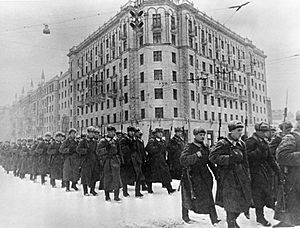Battle of Moscow facts for kids
Quick facts for kids Battle of Moscow |
|||||||
|---|---|---|---|---|---|---|---|
| Part of the Eastern Front of World War II | |||||||
 December 1941. Fresh forces going to the front from Moscow. |
|||||||
|
|||||||
| Belligerents | |||||||
| Nazi Germany | Soviet Union | ||||||
| Commanders and leaders | |||||||
| Fedor von Bock Heinz Guderian Albert Kesselring |
Georgy Zhukov Aleksandr Vasilevsky |
||||||
| Strength | |||||||
| As of 1 October 1941: 1,000,000 men, 1,700 tanks, 14,000 guns, Aircraft at first: 549 can be used At time of Counter offensive: 599 |
As of 1 October 1941: 1,250,000 men, 1,000 tanks, 7,600 guns, Aircraft at first: 936 (545 can be used) At time of Counter offensive: 1,376 |
||||||
| Casualties and losses | |||||||
| 280,000-400,000 | 650,000–1,280,000 (mostly captured) | ||||||
The Battle of Moscow (Russian: Битва под Москвой, German: Schlacht um Moskau) is a name given by Soviet historians to two periods of fighting on a 600 km area of the Eastern Front during World War II. It took place between October 1941 and January 1942. The Soviet defenses stopped the German attack on Moscow, the Soviet capital, which was one of the Axis's primary military and political objectives in the invasion of the Soviet Union.
The German strategic offensive named Operation Typhoon was planned to attack Moscow from the north and south. The Soviets reacted by sending in more reserve from the Far East. Shortly, German attacks were stopped, and the Soviets began counter-attack and forced to push the Axis back.
Images for kids
-
Parade by Soviet troops on Red Square, Friday, 7 November 1941, depicted in 1949 painting by Konstantin Yuon vividly demonstrating the symbolic significance of the event
-
Soldiers dressed in Red Army uniforms carrying the standards of the military fronts of the Eastern Front on Red Square, 7 November 2018.
See also
 In Spanish: Batalla de Moscú para niños
In Spanish: Batalla de Moscú para niños


















